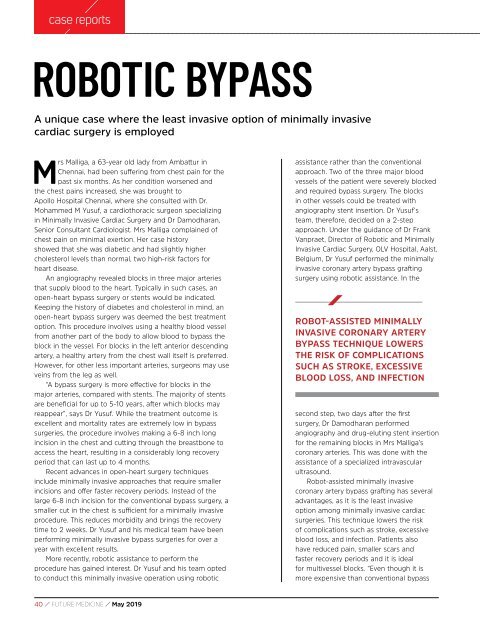may edition file
Create successful ePaper yourself
Turn your PDF publications into a flip-book with our unique Google optimized e-Paper software.
case reports<br />
ROBOTIC BYPASS<br />
A unique case where the least invasive option of minimally invasive<br />
cardiac surgery is employed<br />
Mrs Malliga, a 63-year old lady from Ambattur in<br />
Chennai, had been suffering from chest pain for the<br />
past six months. As her condition worsened and<br />
the chest pains increased, she was brought to<br />
Apollo Hospital Chennai, where she consulted with Dr.<br />
Mohammed M Yusuf, a cardiothoracic surgeon specializing<br />
in Minimally Invasive Cardiac Surgery and Dr Damodharan,<br />
Senior Consultant Cardiologist. Mrs Malliga complained of<br />
chest pain on minimal exertion. Her case history<br />
showed that she was diabetic and had slightly higher<br />
cholesterol levels than normal, two high-risk factors for<br />
heart disease.<br />
An angiography revealed blocks in three major arteries<br />
that supply blood to the heart. Typically in such cases, an<br />
open-heart bypass surgery or stents would be indicated.<br />
Keeping the history of diabetes and cholesterol in mind, an<br />
open-heart bypass surgery was deemed the best treatment<br />
option. This procedure involves using a healthy blood vessel<br />
from another part of the body to allow blood to bypass the<br />
block in the vessel. For blocks in the left anterior descending<br />
artery, a healthy artery from the chest wall itself is preferred.<br />
However, for other less important arteries, surgeons <strong>may</strong> use<br />
veins from the leg as well.<br />
“A bypass surgery is more effective for blocks in the<br />
major arteries, compared with stents. The majority of stents<br />
are beneficial for up to 5-10 years, after which blocks <strong>may</strong><br />
reappear”, says Dr Yusuf. While the treatment outcome is<br />
excellent and mortality rates are extremely low in bypass<br />
surgeries, the procedure involves making a 6-8 inch long<br />
incision in the chest and cutting through the breastbone to<br />
access the heart, resulting in a considerably long recovery<br />
period that can last up to 4 months.<br />
Recent advances in open-heart surgery techniques<br />
include minimally invasive approaches that require smaller<br />
incisions and offer faster recovery periods. Instead of the<br />
large 6-8 inch incision for the conventional bypass surgery, a<br />
smaller cut in the chest is sufficient for a minimally invasive<br />
procedure. This reduces morbidity and brings the recovery<br />
time to 2 weeks. Dr Yusuf and his medical team have been<br />
performing minimally invasive bypass surgeries for over a<br />
year with excellent results.<br />
More recently, robotic assistance to perform the<br />
procedure has gained interest. Dr Yusuf and his team opted<br />
to conduct this minimally invasive operation using robotic<br />
assistance rather than the conventional<br />
approach. Two of the three major blood<br />
vessels of the patient were severely blocked<br />
and required bypass surgery. The blocks<br />
in other vessels could be treated with<br />
angiography stent insertion. Dr Yusuf’s<br />
team, therefore, decided on a 2-step<br />
approach. Under the guidance of Dr Frank<br />
Vanpraet, Director of Robotic and Minimally<br />
Invasive Cardiac Surgery, OLV Hospital, Aalst,<br />
Belgium, Dr Yusuf performed the minimally<br />
invasive coronary artery bypass grafting<br />
surgery using robotic assistance. In the<br />
ROBOT-ASSISTED MINIMALLY<br />
INVASIVE CORONARY ARTERY<br />
BYPASS TECHNIQUE LOWERS<br />
THE RISK OF COMPLICATIONS<br />
SUCH AS STROKE, EXCESSIVE<br />
BLOOD LOSS, AND INFECTION<br />
second step, two days after the first<br />
surgery, Dr Damodharan performed<br />
angiography and drug-eluting stent insertion<br />
for the remaining blocks in Mrs Malliga’s<br />
coronary arteries. This was done with the<br />
assistance of a specialized intravascular<br />
ultrasound.<br />
Robot-assisted minimally invasive<br />
coronary artery bypass grafting has several<br />
advantages, as it is the least invasive<br />
option among minimally invasive cardiac<br />
surgeries. This technique lowers the risk<br />
of complications such as stroke, excessive<br />
blood loss, and infection. Patients also<br />
have reduced pain, smaller scars and<br />
faster recovery periods and it is ideal<br />
for multivessel blocks. “Even though it is<br />
more expensive than conventional bypass<br />
40 / FUTURE MEDICINE / May 2019


















